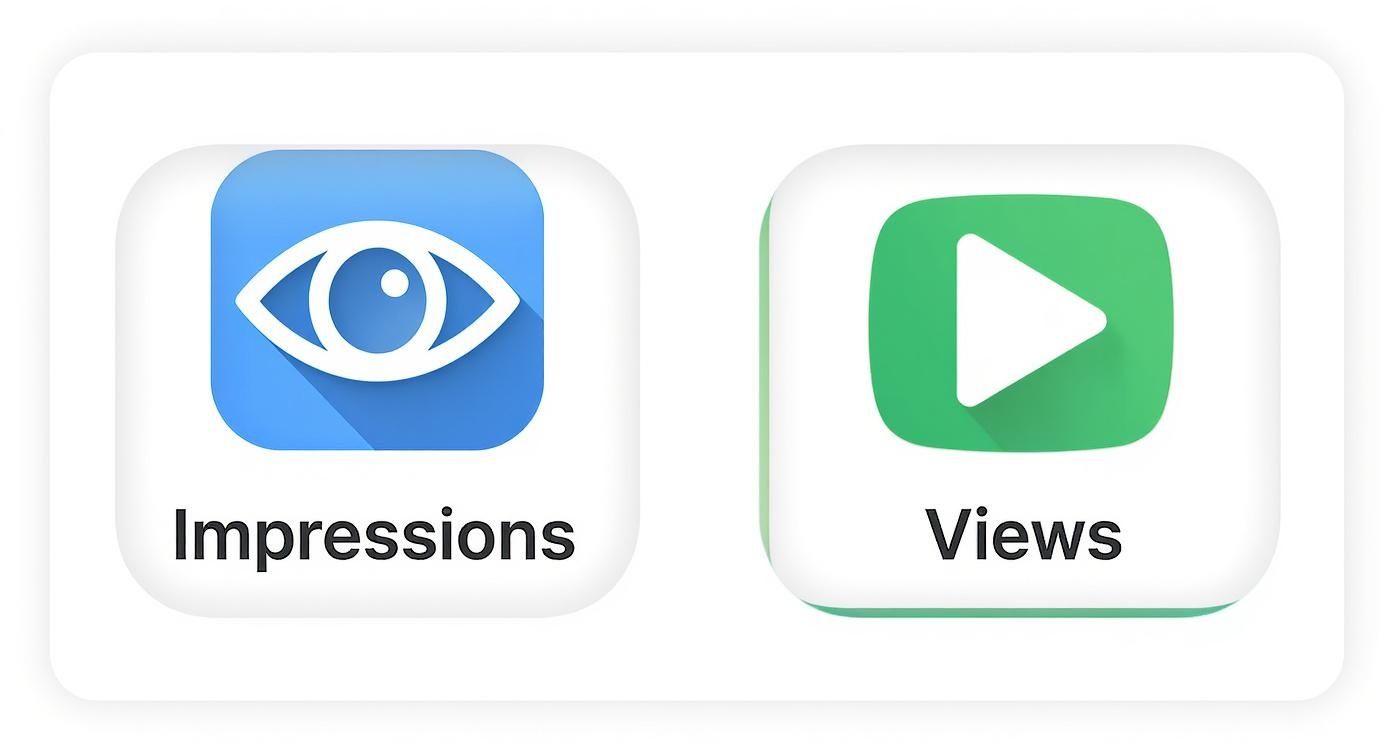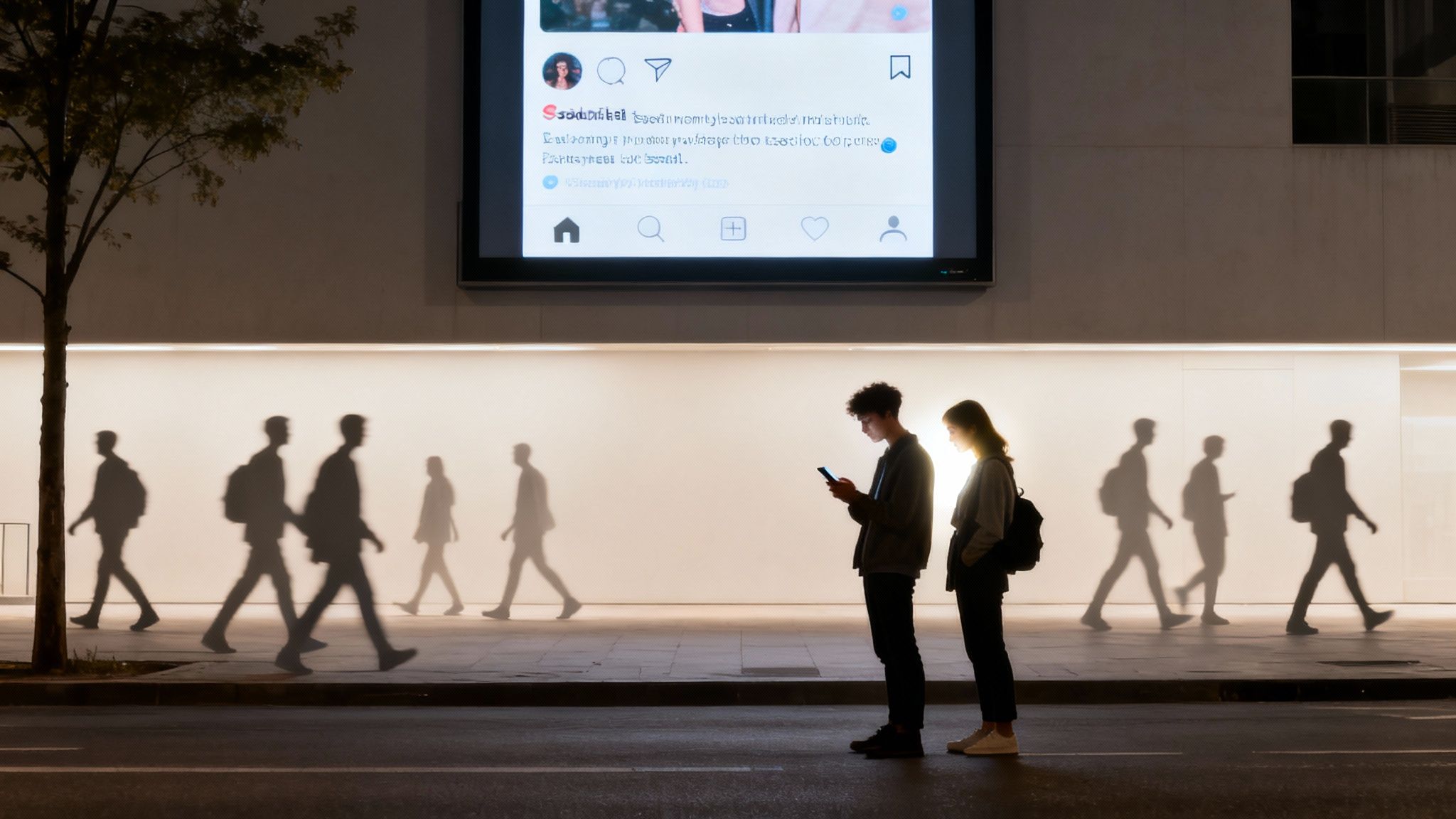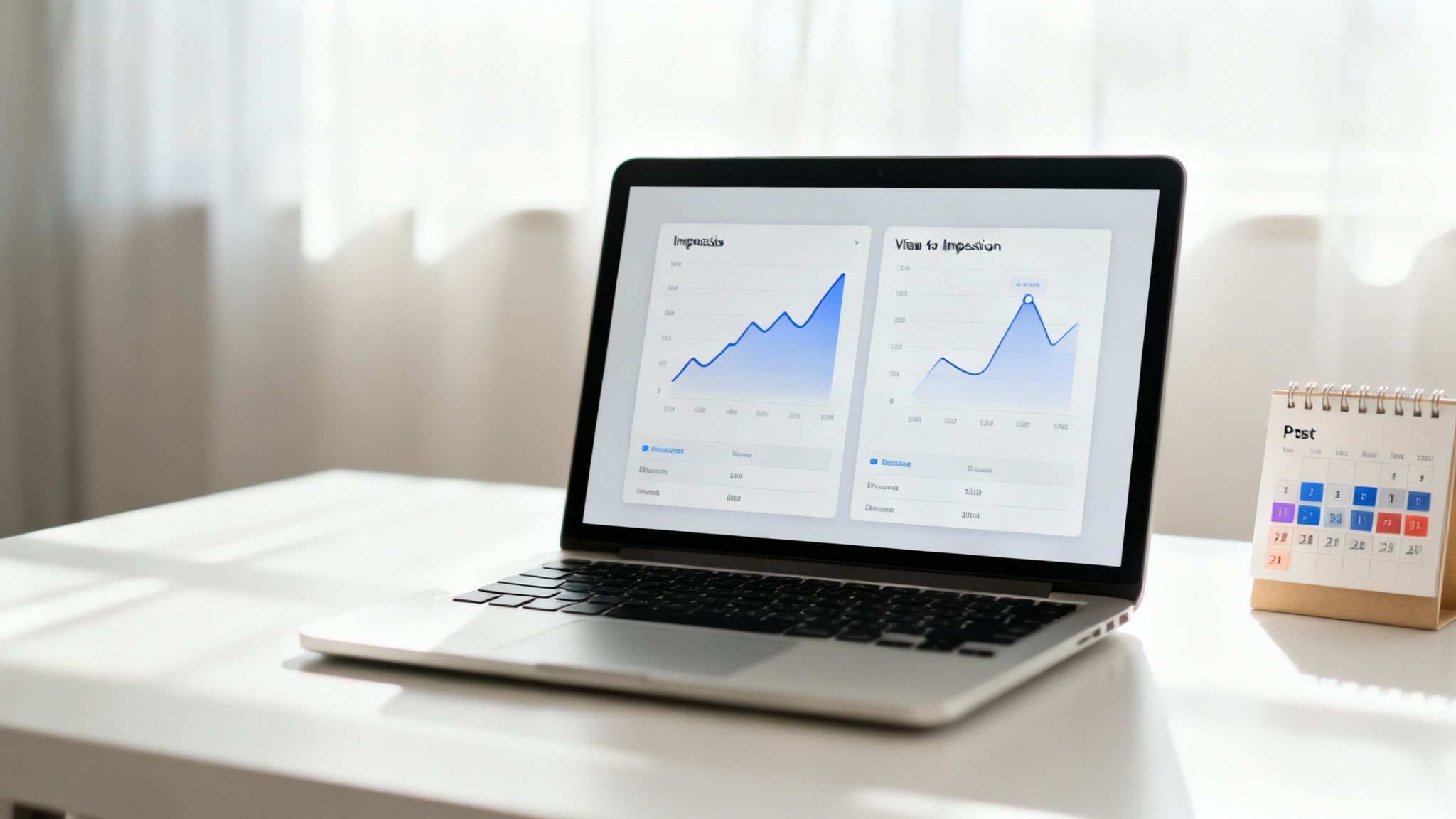Let's cut right to it. The core difference is simple: an impression is when your content shows up on someone's screen, but a view happens when they actually watch it.
Think of it as the difference between passive exposure and active engagement. Deciding which one matters more comes down to a single question: are you aiming for broad awareness or a deeper connection?
The Fundamental Difference Between Views and Impressions
To really nail down the views vs. impressions debate, let's use a quick analogy. Picture your content as a billboard on a busy highway. Every single car that passes by counts as an impression—it's an opportunity to be seen.
A view, on the other hand, is when a driver actually slows down, turns their head, and reads your entire message. It’s a deliberate act. It's someone choosing to give you their attention.
This distinction is everything. Impressions tell you about your potential reach, showing how many times your content was delivered into someone’s feed. Views tell you about actual, honest-to-goodness attention.
Breaking Down the Core Concepts
Here’s where it gets practical. If one person scrolls past your post three separate times, that’s three impressions. But if they only stop to watch the video once, that’s just a single view. This is why a post with 10,000 impressions might only have 2,000 views. In that scenario, only 20% of the potential audience actually stopped to engage.
Getting a grip on this helps you connect the dots between what’s happening on social media and your bigger business goals. When you learn to monitor web traffic like an expert, you start seeing how these on-platform metrics translate into real-world results.
An impression is an opportunity, but a view is a conversation starter. One tells you who you could reach; the other tells you who is actually listening.
To make it even clearer, here’s a quick breakdown of how these two metrics stack up.
Views vs Impressions At a Glance
This table lays out the essential differences at a glance, giving you a quick reference for what each metric truly represents.
| Metric | What It Measures | User Action | Primary Value |
|---|---|---|---|
| Impressions | How many times content is displayed on a screen. | None—passive scrolling is enough. | Measures potential reach and brand visibility. |
| Views | How many times content is actively watched. | Intentional action (e.g., watching for 3+ seconds). | Measures genuine interest and engagement. |
Ultimately, impressions are about getting your foot in the door, while views are about being invited to stay for a while. Both are useful, but they tell very different stories about your content's performance.
How Platforms Define Views and Impressions Differently
Just when you think you’ve got a handle on views vs. impressions, you realize every social media platform plays by its own rules. It’s one of the biggest headaches for marketers. What counts as a “view” on one network might barely qualify as an “impression” on another, making cross-channel comparisons a nightmare.
Without digging into these platform-specific definitions, you’re flying blind. You can’t accurately compare a video’s performance on LinkedIn to its performance on YouTube unless you know exactly how each one measures engagement. You’ll end up drawing all the wrong conclusions about what’s working.
This infographic breaks down the core difference in a nutshell before we get into the nitty-gritty of each platform.

As you can see, an impression is passive—just showing up on a screen. A view, on the other hand, requires some level of active watching.
LinkedIn’s Unique Approach
LinkedIn draws a very clear line in the sand between these two metrics. An impression is counted anytime your content (a post, image, or video) simply appears in someone’s feed. Think of it as a measure of potential visibility.
A video view is a completely different story. LinkedIn has much stricter criteria.
On LinkedIn, a video view is only registered after a user watches for at least two consecutive seconds with 50% or more of the video player visible on their screen.
This rule is a game-changer because it separates a fleeting scroll from genuine, even if brief, attention. It's a critical piece of the puzzle for anyone trying to understand what actually drives reach on the platform.
Contrasting Major Social Platforms
This is where things get really messy for cross-platform analysis. Every other major player has its own take. Here’s a quick rundown of the different rulebooks:
- YouTube: This is the gold standard. YouTube sets the highest bar, requiring a user to watch for at least 30 seconds (or the entire video if it’s shorter) to count a view. A YouTube view is a powerful signal of genuine interest.
- Instagram & Facebook (Meta): It’s a bit of a mixed bag. For Reels, a view is typically counted after just three seconds. But for other formats like static images, Meta has started using the term "views" for what we used to call impressions—basically, any time the content is displayed.
- TikTok: The rules here are the most relaxed. A view is counted the instant a video starts playing in a feed. There's no minimum watch time, which helps explain why view counts on TikTok can skyrocket compared to other platforms.
Understanding these nuances is everything. A campaign that pulls in 100,000 views on TikTok is not the same as one that gets 100,000 views on YouTube. Each metric tells a completely different story about audience attention, and it’s all down to the platform’s specific rules.
What High Impressions and Low Views Really Mean
Ever had that sinking feeling when a post racks up thousands of impressions but only a handful of views? It’s a common frustration, and it feels like you're shouting into the void. Your content is technically reaching people, but nobody is actually stopping to listen.
This gap between your potential audience and your actual audience is one of the most powerful diagnostic tools you have.
When your impressions are sky-high but your views are stubbornly low, it’s a crystal-clear signal that your content failed to grab attention at the most critical moment: the first glance. It means your post appeared in countless feeds, but something about your thumbnail, headline, or the opening line of your text wasn't compelling enough to stop the scroll.

This isn't just you; it happens all the time. One report found that while a whopping 93% of businesses landed a new customer from a social media video, a tiny 16% of marketing videos manage to break 100,000 views. This huge difference shows that a post with 50,000 impressions might only translate into 5,000 views—a 10% conversion rate from impression to view. That gap usually points directly to a weak hook or messaging that just didn't land.
Diagnosing the Impression-to-View Gap
Think of your impression-to-view ratio as a direct grade on your content’s first impression. A low score forces you to ask some tough questions about how your content shows up in the feed.
Here are the usual suspects:
- A Generic Thumbnail: Does your video’s cover image look like a stock photo, or does it actually spark some curiosity?
- A Weak Opening Line: Does the first sentence of your post hit on a pain point or make a bold claim right away?
- A Vague Headline: Does your title clearly promise value, or is it trying to be too clever and just ends up being confusing?
A high number of impressions proves the algorithm is giving your content a chance. A low number of views proves your audience isn't. The problem isn't visibility; it's the hook.
On the flip side, a strong ratio—where a high percentage of those impressions turn into views—tells you that your initial packaging is working beautifully. It’s confirmation that your thumbnail, headline, and opening text are a powerful combination, successfully stopping people mid-scroll and convincing them to stick around.
A Practical Example of Fixing the Gap
Let’s say you post a video tutorial on LinkedIn titled "New Software Features." It gets 20,000 impressions but only 800 views—that’s a bleak 4% view rate. The problem is obvious: the title is boring and doesn't scream "immediate value" to a busy professional scrolling through their feed.
So, you decide to A/B test a new version. The video itself is identical, but you change the packaging:
- New Title: "This 60-Second Trick Will Save You an Hour Every Day"
- New Thumbnail: A screenshot of the most impactful "aha!" moment in the tutorial, with some bold text layered on top.
The new version also gets 20,000 impressions, but this time it scores 3,000 views—a much healthier 15% view rate. The content didn't change at all, but the hook did. By analyzing the gap between your views and impressions, you found and fixed the weakest link in your content strategy. To get a better feel for what you should be aiming for, it can be helpful to look into what constitutes a good view rate on platforms like TikTok to set smarter benchmarks.
When Your Goal Should Be Maximizing Impressions

While views often get all the glory, writing off impressions is a huge strategic mistake. In the whole views vs impressions debate, there are absolutely times when getting in front of as many eyeballs as possible is the right move. Think of it as a top-of-funnel play—it’s all about building familiarity before you even dream of asking for a click or a follow.
Before someone can engage with your content, they first have to know you even exist. Impressions are the engine that drives brand awareness, pushing your name, logo, and message into the feeds of the right people, over and over again.
Key Scenarios for an Impression-Focused Strategy
Not every campaign is about driving deep engagement. Sometimes, you just need to be seen.
Here’s when you should make impressions your North Star:
- Brand Awareness Campaigns: If you're the new kid on the block or breaking into a new market, your primary job is to get on people's radar. A high impression count makes your brand a familiar face in your audience's feeds.
- Major Announcements: Launching a new product? Sharing a huge company milestone? You need to get that news out far and wide, fast. The goal is to saturate the market with your announcement.
- Staying Top-of-Mind: In a crowded space, visibility is survival. Consistent impressions are like gentle nudges, keeping your brand in the conversation when your audience is ready to buy.
An impression-led strategy is about playing the long game. It’s built on that old marketing rule of thumb: it takes seven or more touchpoints before someone really starts to recognize and trust a brand.
The Strategic Rationale for Prioritizing Reach
Choosing to focus on impressions is a deliberate move to build a foundation of familiarity. For instance, a B2B tech firm might push out a series of simple, branded graphics on LinkedIn. These posts might not get the same deep views as a video, but they can rack up a massive number of impressions with very little friction.
That constant repetition means when a potential customer finally starts looking for a solution, your brand is the first one that pops into their head. It’s a less direct, but incredibly powerful, way to shape future buying decisions. By understanding the strategic value of impressions on LinkedIn, you can start creating content designed specifically to blow up this critical top-of-funnel metric. At the end of the day, the "best" metric is always the one that’s laser-focused on your immediate goal.
When You Need to Focus on Earning Views
Impressions are great for casting a wide net, but there are moments when your strategy has to pivot from broad awareness to genuine engagement. In the views vs impressions debate, this is where a quick glance just won’t cut it. You need someone's undivided attention.
This shift is crucial for content that’s meant to educate, showcase value, or build your authority. A view is a clear signal that someone has stopped scrolling and decided to invest their time in what you have to say. That’s a far stronger indicator of a qualified prospect than a fleeting impression.
Scenarios Demanding a View-Centric Approach
When your goals get more specific than just getting your name out there, views become your north star. Your content can't just show up in the feed; it has to perform.
You should be chasing views in situations like these:
- Lead Generation: If a post is designed to drive demo requests or guide downloads, a view confirms someone is interested enough to learn more. An impression just means they scrolled right past your call to action.
- In-Depth Education: When you're breaking down a complex topic or sharing a detailed tutorial, view duration is everything. It shows your audience is actually absorbing the information you’re taking the time to provide.
- Product Demonstrations: A quick flash of a screenshot won’t sell a sophisticated product. You need people to stick around long enough to see the key features and grasp the real benefits.
- Establishing Thought Leadership: To be seen as an expert, people actually need to consume your insights. Quality views on your analysis or case studies build the kind of credibility that impressions simply can't touch.
Impressions get you in the room, but views are what get you a seat at the table. A view is a conscious choice from your audience to stop and listen, making it a far more valuable currency for building trust and driving action.
Crafting Content That Earns Attention
Let's be clear: content designed for high-quality views is built differently than content made for impressions. It needs more substance and a hook that’s impossible to ignore. Think about creating detailed tutorials or deep-dive case studies for LinkedIn—these formats are engineered to provide so much value that watching becomes an easy decision for the user.
These are the exact kinds of high-value posts that turn passive scrollers into active leads and drive real business outcomes. As you shift your focus, it becomes obvious why views are the new currency of social media success for anyone who's serious about turning attention into revenue.
How to Improve Both Metrics with PostFlow
Knowing the difference between views and impressions is one thing, but actually improving them is where the real work begins. Moving from theory to practice means you need the right tools to turn those insights into action. This is where a platform like PostFlow comes in, helping you execute a smarter, more deliberate content plan.
Let’s get practical. You can use specific features to systematically get more eyes on your content and turn those eyes into active engagement. It all starts with giving your content the best possible shot at being seen in the first place.
Use Scheduling to Maximize Impressions
The quickest win for increasing impressions is to post when your audience is actually online and active. PostFlow’s scheduling feature takes the guesswork out of the equation. You can map out your content ahead of time and have it go live at the moments it’s most likely to get traction.
Let's be real, consistency is a huge signal to the LinkedIn algorithm, and scheduling is your secret weapon for maintaining a steady, reliable presence.
Here's a look at how simple it is to plan your content for peak times.

The interface is straightforward—just pick your date and time. By consistently hitting these high-engagement windows, you’re setting your content up for maximum reach and, you guessed it, a higher impression count.
Create Engaging Content to Drive Views
While scheduling gets you in front of people, earning their views demands content that makes them stop scrolling. This is where I've seen PostFlow’s AI-powered creation tools, especially for native video, really shine. You can use the platform to brainstorm ideas and sharpen your scripts, focusing on powerful hooks that grab attention within the first three seconds.
Boosting views is a direct result of creating more compelling content. PostFlow helps you transform raw ideas from voice recordings into polished, engaging posts that are engineered to hold viewer attention.
To tie it all together, you need to look at the data. PostFlow’s built-in analytics dashboard is where you can track your view-to-impression ratio for every single post. This is your feedback loop. By watching this one metric, you can quickly see which formats and hooks are actually turning passive impressions into active views.
This data-driven approach allows you to:
- Spot Your Winning Formats: Figure out if carousels, videos, or text-only posts are earning the most views relative to their impressions.
- Double Down on What Works: Analyze your top-performing content. What made it pop? Apply those lessons to what you create next.
- Fine-Tune Your Hooks: Test different opening lines and visual styles. Your view-to-impression ratio is the ultimate judge of what’s working.
By combining smart scheduling, AI-assisted content creation, and clear analytics, PostFlow gives you an end-to-end system for tackling both sides of the views vs. impressions equation.
Got Questions? We've Got Answers.
Diving into content metrics can feel a bit like alphabet soup. Let's clear up some of the most common questions I hear about the whole views vs. impressions dynamic.
So, Are More Impressions Always Better?
Not exactly. A massive impression count is great for getting your name out there—think of it as digital window shopping. But it's only one piece of the puzzle.
If all those impressions aren't turning into actual views or clicks, it's a sign your content is being seen but not felt. It’s not strong enough to make someone stop scrolling, which usually means the hook needs some work. Always look at impressions next to your engagement numbers to get the full picture.
Can a Post Have More Views Than Impressions?
Nope, that's impossible. An impression has to happen before a view can be counted. Your content has to pop up on someone's screen (the impression) before they can decide to watch it (the view).
Think of it this way: impressions are the total number of lottery tickets you handed out. Views are how many of those tickets were actual winners. You can't have a winning ticket that was never handed out in the first place.
A view is a subset of an impression. Every view begins its life as an impression, but not every impression graduates to become a view.
What’s a Good View-to-Impression Ratio to Aim For?
This is the million-dollar question, and honestly, there's no single magic number. It swings wildly depending on the platform, your industry, and the type of content you're putting out.
That said, for a LinkedIn video, a 10-20% view-to-impression ratio is a pretty solid benchmark to start with.
The best move? Compete against yourself. Track your own performance over time and focus on inching that ratio up. Test different hooks, play with your visuals, and see what messaging really connects with your audience.
Ready to stop guessing and start creating LinkedIn content that consistently performs? Let PostFlow and your personal AI content strategist, Emilia, turn your expertise into posts that grab attention and get results. Start growing your LinkedIn presence with PostFlow today.


